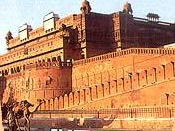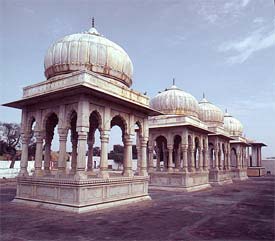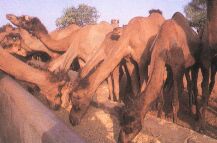|
BIKANER
 This desert town in the north of the state was founded in 1488 by Rao
Bikaji, a descendant of the founder of Jodhpur, Jodhaji. Like many others
in Rajasthan, the old city is surrounded by a high crenellated wall and,
like Jaisalmer, it was once an important staging post on the great caravan
trade routes. The Gang Canal, built between 1925 and 1927, irrigates a
large area of previously arid land around Bikaner. This desert town in the north of the state was founded in 1488 by Rao
Bikaji, a descendant of the founder of Jodhpur, Jodhaji. Like many others
in Rajasthan, the old city is surrounded by a high crenellated wall and,
like Jaisalmer, it was once an important staging post on the great caravan
trade routes. The Gang Canal, built between 1925 and 1927, irrigates a
large area of previously arid land around Bikaner.
Although it’s less impressive than Jaisalmer,
Bikaner is still an interesting place to visit, but not many travellers
stop here. There’s a superb large fort, a government camel breeding farm
just outside the town, and 30 km to the south is the Karni Mata Temple
where thousands of holy rats are worshipped.
Orientation
The old city is encircled by a seven-km long city wall with five
entrance gates, constructed in the 18th century. The fort and
palace, built of the same reddish-pink sand-stone as Jaipur’s famous
buildings, are outside the city walls.
Junagarh Fort
 Constructed between 1588 and 1593 by Raja Rai Singh, a general in the
army of the Mughal emperor, Akbar, the fort has a 986 –metre-long wall
with 37 bastions and two entrances. The Suraj Pol, or Sun Gate, is the
main entrance to the fort. The palaces within the fort are on the southern
side and make a picturesque ensemble of courtyards, balconies, kiosks,
towers and windows. A major feature of this fort and its palaces is the
superb quality of the stone carving- it rivals the best anywhere in the
world. Constructed between 1588 and 1593 by Raja Rai Singh, a general in the
army of the Mughal emperor, Akbar, the fort has a 986 –metre-long wall
with 37 bastions and two entrances. The Suraj Pol, or Sun Gate, is the
main entrance to the fort. The palaces within the fort are on the southern
side and make a picturesque ensemble of courtyards, balconies, kiosks,
towers and windows. A major feature of this fort and its palaces is the
superb quality of the stone carving- it rivals the best anywhere in the
world.
Among the places of interest are the Chandra
Mahal, or Moon Palace, with paintings, mirrors and carved marble
panels. The Phool Mahal, or flowers is also decorated with glass
and mirrors. The Karn Mahal was built to commemorate a notable
victory over the Mughal Aurangzeb.
Other palaces include the Rang Mahal, Bijai Mahal and Anup
Mahal. The contents include the usual Rajput weapon collection, not to
mention the decaying pieces of a couple of old WW I biplanes. The Durga
Niwas is a beautifully painted courtyard while the Ganga Niwas, another
large courtyard, has a finely carved red sandstone front, Har Mandir is
the royal temple, dedicated to Siva.
The fort is open daily except Friday from 10 am to 4:30 pm.
Lalgarh Palace
 Three km north of the city centre, this red sandstone palace was built
by Maharaja Ganga Singh (1881-1942) in memory of his father Maharaja Lal
Singh. Although it’s a grand building with overhanging balconies and
delicate latticework, it’s not the most beautiful of Rajasthani royal
residences. Three km north of the city centre, this red sandstone palace was built
by Maharaja Ganga Singh (1881-1942) in memory of his father Maharaja Lal
Singh. Although it’s a grand building with overhanging balconies and
delicate latticework, it’s not the most beautiful of Rajasthani royal
residences.
The Shri Sadul Museum covers the entire
first floor of the palace. A fawning brochure describe the contents as
’some gorgeous paintings and other rare artifacts that reveal these
maharaja’s appreciation and profound interest for art skill and
brilliance’. But the museum is worth seeing, and houses an incredible
array of photos, and an extraordinary collection of the former
maharaja’s personal possessions- golf clubs, camera, clothes, books,
passport, glasses, earplugs and electric toothbrush! There’s also the
usual exhibition of Indian wildlife, shot and stuffed.
The Bikaner royal family still lives in part of
the palace, while the rest has been turned into a luxury hotel. The museum
is open from 10 am to 5 pm.
Other Attractions
 The narrow odoriferous streets of the old city conceal a number of old
havelis and a couple of notable Jain temples. Built by two
brothers, the Bhandeshwar and Sandeshwar temples date from the 14th
century. Unlike most other Jain temples in Rajasthan they are decorated
inside with colourful wall paintings. The narrow odoriferous streets of the old city conceal a number of old
havelis and a couple of notable Jain temples. Built by two
brothers, the Bhandeshwar and Sandeshwar temples date from the 14th
century. Unlike most other Jain temples in Rajasthan they are decorated
inside with colourful wall paintings.
The Ganga Golden Jubilee Museum contains
a collection of sculpture, terracotta ware, coins, paintings and arms.
It’s open daily except Friday from 10am to 5 pm.
Things to Buy
On the right –hand side as you enter the fort, by the tourist
office, is an excellent craft shop, run by the Urmul Trust. Items sold
here are of high quality and made by people from surrounding villages.
Proceeds go directly to improve health and education projects in these
villages. You can browse here without the usual constant hassles to buy.
Getting There & Away
Air: The airport is 15 km from the centre but not currently served by
any airline.
Bus: The bus stand is three km north of the
city centre, right opposite the Lalgarh Palace. There are at least two
RSTC buses daily between Bikaner and Jaisalmer (8 hours).
The Jaipur buses go via the Shekhawati town of Fatehpur (4
½ hours). Other places served by bus from Bikaner include Udaipur
(13hours), Ajmer (7 hours), Agra and Delhi.
Train: The computerized booking office, open
daily from 8 am to 8 pm, is in the building to the right as you approach
the station.
Bikaner is now connected to
Jodhpur and Jaipur by broad-gauge line. Service on the 463 –km metre-gauge
trip to Delhi.
AROUND BIKANER
Bhand Sagar Temple
The 16th –century Jain temple to the 23rd
Tirthankar, Parasvanath, is the most important of the complex. Others
include the Chintamani Temple of 1505 and the Adinath Temple.
There is a fine view of the city wall and surrounding countryside from the
park behind the temple.
Devi Kund

Eight km east of Bikaner, this is the site of the royal chhatris
(cenotaphs) of many of the Bika dynasty rulers. The white marble chhatri
of Maharaja Surat Singh is among the most imposing.
Camel Breeding Farm
This government-managed camel breeding station, eight km from
Bikaner,
is probably unique in Asia. There are hundreds
of camels here and it’s great sight in the
 late
afternoon as the camels come back from gazing.
The
British army had a camel corps drawn from
Bikaner during WW I. late
afternoon as the camels come back from gazing.
The
British army had a camel corps drawn from
Bikaner during WW I.
The farm is open afternoons only and rides are
available. Half the auto-rickshaw and taxi drivers in Bikaner appear to be
on the lookout for tourists to take out there, but you need to bargain
hard with them. For the round trip including a half-hour wait at the farm.
Gajner Wildlife Sanctuary
The lake and forested hills of this reserve, 32 km from Bikaner on the
Jaisalmer road, are inhabited by wildfowl and a number of deer and
antelope. Imperial sand grouse migrate here in winter.
The old royal summer palace, on the banks of the lake,
is now the Gajner Palace Hotel.
Deshnok
Following the highly publicized 1994 outbreak of plague in India,
state governments have been attempting to reduce rat populations with
heavy use of pesticides. Of course, this being India, not all rats are on
the death list. The thousands that inhabit the Karni Mata Temple in
Deshnok are further incarnations of mystics and sadhus, so pest control
here would be sacrilege.
A visit to this fascinating temple, dedicated to Karni Mata,
an incarnation of Durga, is not for the squeamish. Once you’ve admired
the huge silver gates and marble carvings donated by Maharaja Ganga Singh,
you plunge into the sea of swarming rodents, hoping that some will scamper
over you feet –most auspicious. Little boys pick them up by their tails
and let them perch on your shoulders. Devotees buy Prasad to offer to the
rats, finishing off anything they may leave. Eating Prasad that has been
salivated over by these holy rats brings even greater good fortune, but is
not recommended for wimpish Western constitutions.
|





